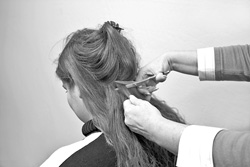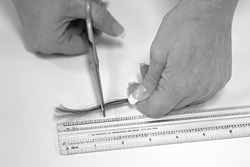Most Commonly Asked Questions
What is a Hair Tissue Mineral Analysis?
A hair tissue mineral analysis (HTMA) simply stated, is a screening test that measures the mineral content of your hair. However, a hair tissue mineral analysis is much more than a test for minerals. Providing a blueprint of one's biochemistry, a hair tissue mineral analysis can provide pertinent information about your metabolic rate, energy levels, carbohydrate tolerance, stage of stress, immune system and glandular activity. This screening test can also be used to reduce the guesswork involved when recommending nutritional supplements and dietary modifications.

Is Hair Analysis A Valid Basis For Evaluation Of A Person's Chemistry?
Blood tests and urine tests obviously provide important information about a person's biochemical status, but they only evaluate the fluids in the body. However, the vast majority of biochemical functions actually take place inside the cells themselves. Of course, we can't conveniently take snips out of the various organs of a person's body in order to evaluate what is going on in the cells, but there are cells conveniently available to us, the cells of the hair. Through extensive research and correlation of data, it has been established that there are reliable relationships between the levels of minerals in the hair and other tissues of the body. Thus, analysis of the mineral content of an individual's hair can provide us with a general 'blueprint' of the mineral content in the rest of the body's tissues. Since these minerals are crucial to the functioning of enzymes, hormones and other biochemical systems which sustain life, it is possible to read this 'blueprint' and see where metabolic patterns are deviating from normal.
Another benefit of hair analysis is that it may be used to assist the health care professional to pinpoint the development of metabolic dysfunctions often before symptoms manifest. While mineral imbalances in the body do eventually show up in the blood serum, they will not do so until the condition is so advanced that the individual is often experiencing overt symptoms. Tissue mineral analysis allows us to determine that an imbalance exists, before the imbalance begins to manifest disturbances on a symptomatic level. Therefore, the imbalance can often be corrected through nutritional therapy even before a person begins to suffer from metabolic symptoms.
Why Does My Lab Report From Analytical Research Labs Vary So Much From Other Hair Analysis Reports?
Mineral levels and ratios as determined by Analytical Research Labs for each individual are measured against an 'ideal' standard of health, rather than an 'average' standard as used by other laboratories. This renders our results more sensitive and meaningful to those people who aspire to optimum levels of health.
We work with precise mineral levels and ratios rather than with the broad ranges employed by the majority of professionals engaged in hair analysis. As a result, we identify even slight deviations from 'ideal' values responsible for some disorders which would escape detection by other labs.
Our tests recognize biochemical individuality through determination of three basic oxidation types, thus providing a sound basis for an accurate and specific selection of nutrients based on the individual's metabolism. Detrimental health effects arising from mismatching of nutrients with individual metabolism are therefore avoided.
Accutrace Laboratories, Inc. (CLIA #03D0641886) is a CLIA Certified Laboratory. What Does This Mean?
This certification means that Accutrace Laboratories Inc.(a wholly owned subsidiary of ARL) has met or exceeded the requirements of an inspection conducted by the Department of Health & Human Services. These inspections are conducted every two years.
What is CLIA?
CLIA is an acronym for Clinical Laboratory Improvement Amendments.
What Kind of Instrumentation Does Accutrace Laboratories Use?
Our laboratory currently uses the Perkin Elmer Elan 9000 ICP Mass Spectrometer.
What Does ICP-MS Stand For?
ICP is an acronym for Inductively Coupled Plasma-Mass Spectrometry.
How Does Accutrace Laboratories Report Test Results?
We report our results in Mg% (milligrams percent) or milligrams per 100 grams of hair. This means that 100 grams of hair would contain the reported number of milligrams of the minerals listed. Some possible equivalent ways these units might be referred to are milligrams percent and milligram per deciliter.
Another method of reporting test results(sometimes used by other laboratories) is ppm(parts per million). To convert ppm to Mg% one would divide the results reported in ppm by 10. For example, 500 ppm/10 equals 50 Mg%. To convert our results to parts per million; simply multiply our result by 10.
What is the Minimum Amount of Hair to Perform the Multi-Element Mineral Assay?
We currently require a minimum of 125 mgs of hair to complete the entire mineral assay.
Are There Any Special Requirements For Submitting a Hair Sample?
The accuracy and reliability of the test results and interpretation is based upon the laboratory receiving a properly collected hair sample that is clean and free from external contaminants. The ideal hair sample should be collected prior to subjecting the hair to any treatments such as bleaching, permanents, or dyes. This also includes the application of hair sprays, hair creams, gels and oils. Additionally, the hair should be washed within 24 hours of sampling and must be dry for at least 4 hours after shampooing.

There are several cautions and concerns regarding hair products. Most shampoos, rinses and conditioners do not contain metals and will not effect the accuracy of the analysis. However, medicated shampoos of concern are Selsun Blue(selenium) and Head and Shoulders(zinc). Grecian Formula contains lead and iron.
The hair sample should be cut as close to the scalp as possible and should be a maximum of 1.5 inches in length. The distal end of the hair longer than 1.5 inches should be discarded.

The recommended location for collection would be the nape of the neck.
It is very important to place the hair sample in the sampling envelope provided before sending to the laboratory. Do not place hair samples in plastic baggies or aluminum foil. Do not tape or staple the hair sample to the scale or sampling envelope.
Do not mix different types of hair such as head hair with pubic hair or beard hair in the same sampling envelope. We strongly recommend using head hair only due to it's consistent rate of growth. Pubic and other body hair should only be used if sufficient head hair is not available.
How Long Does It Take To Have My Hair Tested?
The laboratory procedure generally takes 2-3 days. An additional day may be needed if the sample requires the verification of a test result. Results are returned via the United States Postal Service and we use USPS Priority Mail Service when applicable.
What If I Want a Report Express Mailed?
We can send a completed report via U.S. Postal Service overnight, Federal Express and United Parcel Service. Fees for express delivery services will be added to your invoice. We charge only the fees the carrier charges us. International rates are more expensive.
Who Can Open a Professional Account With ARL?
CLIA regulations require laboratories providing "high complexity" testing to provide their services only to licensed health care practitioners. We therefore require a copy of a practicing license or diploma from the health care professional to establish an account with ARL. This can be mailed, emailed or sent by fax to our facility. Please be sure to include your address and phone number. Upon receipt of the required documents a "New Account" packet will be promptly mailed.
Copyright ©2004-2019
